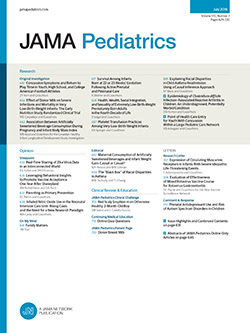Nurse Workload and Missed Nursing Care in Neonatal Intensive Care Units.
IF 18
1区 医学
Q1 PEDIATRICS
引用次数: 0
Abstract
Importance High nurse workload can compromise quality of care in neonatal intensive care units, leading to preventable harm and worsening clinical outcomes. Objective To evaluate differential effects of objective and subjective nurse workload on missed nursing care. Design, Setting, and Participants The prospective, observational, longitudinal design of this cross-sectional study was used to evaluate associations between shift-level workload of participating nurses and missed care for assigned infants from April 2021 to May 2023. This study was conducted at 10 level II, III, and IV neonatal intensive care units among a convenience sample of registered nurses who provided direct patient care at least 16 hours biweekly, completed unit orientation, owned a smartphone, and did not work in a supervisory capacity. Deidentified electronic health record data from infants assigned to nurse participants were extracted through an honest broker arrangement. Data analysis was conducted from July 2023 to July 2025. Exposure Nurse workload was assessed each shift based on objective (maximum number of assigned infants, infant acuity score) and subjective (National Aeronautics and Space Administration [NASA] Task Load Index) measures. Main Outcome and Measures The primary outcome, infant-specific missed nursing care on a shift, was measured by nurse self-report of omission of 17 essential types of neonatal nursing care. Results A total of 247 nurses involved in direct care provided reports of staffing and workload corresponding to the care of 1468 individual infants across 11 364 matched nurse-infant shifts. Nurses were 98% female, and nurses' mean (SD) neonatal intensive care unit experience was 5.7 (7.1) years. When modeling workload variables separately, a shift-level staffing ratio of 3 infants per nurse was significantly associated with increased odds of missed care for individual infants in 9 of 17 types of care; a 2:1 ratio was associated with increased odds in 2 of 17 types of care. Higher subjective workload ratings were associated with increased odds of missed care in all 17 types of care. Negative effects of higher subjective workload persisted across all types of care in joint workload models, while effects of staffing ratios diminished. Few clinically meaningful effects of infant acuity scores on missed care were observed. Conclusions and Relevance In this cross-sectional study, nurses' subjective workload and shift-level staffing ratios exerted direct effects on reliable care delivery. High subjective workload and staffing ratios greater than 2 infants per nurse should be targets for workload reduction in neonatal intensive care units.新生儿重症监护病房护士工作量和护理遗漏。
高护士工作量会降低新生儿重症监护病房的护理质量,导致可预防的伤害并恶化临床结果。目的评价客观护理工作量与主观护理工作量对护理遗漏的差异影响。设计、环境和参与者本横断面研究采用前瞻性、观察性、纵向设计来评估2021年4月至2023年5月期间参与研究的护士轮班水平工作量与指定婴儿错过护理之间的关系。本研究在10个二级、三级和四级新生儿重症监护室进行,选取了方便的注册护士样本,这些护士每两周提供至少16小时的直接患者护理,完成了单元指导,拥有智能手机,并且不以监督身份工作。通过诚实的经纪人安排,从分配给护士参与者的婴儿中提取未识别的电子健康记录数据。数据分析时间为2023年7月至2025年7月。根据客观指标(分配的最大婴儿数量、婴儿视力评分)和主观指标(美国国家航空航天局[NASA]任务负荷指数)评估每班护士的工作量。主要结果和测量方法主要结果为轮班期间婴儿特异性护理缺失,通过护士自我报告17种基本新生儿护理缺失来测量。结果共有247名护士参与直接护理,在11 364个匹配的护士-婴儿轮班中提供了1468名婴儿的相应人员配置和工作量报告。护士中98%为女性,护士在新生儿重症监护病房的平均(SD)经验为5.7(7.1)年。当对工作量变量单独建模时,17种护理类型中的9种中,每名护士3名婴儿的轮班水平人员配置比例与个别婴儿错过护理的几率增加显著相关;2:1的比例与17种护理中2种的几率增加相关。在所有17种类型的护理中,较高的主观工作量评分与错过护理的几率增加有关。在联合工作量模型中,较高主观工作量的负面影响持续存在于所有类型的护理中,而人员配备比例的影响减弱。没有观察到婴儿视力评分对错过护理有临床意义的影响。结论与相关性在本横断面研究中,护士的主观工作量和轮班人员比例对可靠的护理服务有直接影响。高主观工作量和每名护士大于2个婴儿的人员配置比例应成为新生儿重症监护病房减少工作量的目标。
本文章由计算机程序翻译,如有差异,请以英文原文为准。
求助全文
约1分钟内获得全文
求助全文
来源期刊

JAMA Pediatrics
PEDIATRICS-
CiteScore
31.60
自引率
1.90%
发文量
357
期刊介绍:
JAMA Pediatrics, the oldest continuously published pediatric journal in the US since 1911, is an international peer-reviewed publication and a part of the JAMA Network. Published weekly online and in 12 issues annually, it garners over 8.4 million article views and downloads yearly. All research articles become freely accessible online after 12 months without any author fees, and through the WHO's HINARI program, the online version is accessible to institutions in developing countries.
With a focus on advancing the health of infants, children, and adolescents, JAMA Pediatrics serves as a platform for discussing crucial issues and policies in child and adolescent health care. Leveraging the latest technology, it ensures timely access to information for its readers worldwide.
 求助内容:
求助内容: 应助结果提醒方式:
应助结果提醒方式:


